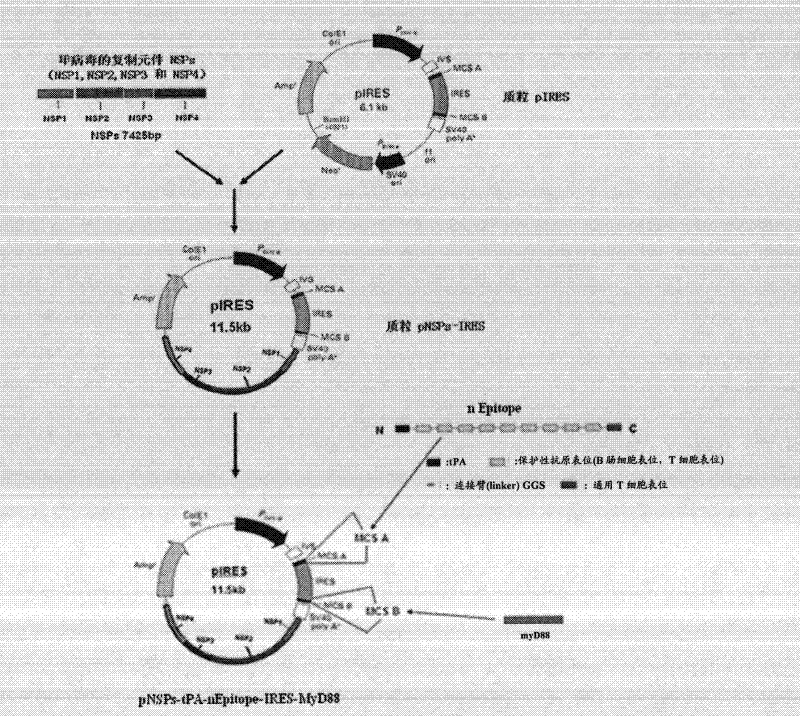Helicobacter pylori antigenic peptide and its application
A technology of Helicobacter pylori and antigenic peptide, applied in the field of immunology, can solve problems such as affecting growth rate or egg production
- Summary
- Abstract
- Description
- Claims
- Application Information
AI Technical Summary
Problems solved by technology
Method used
Image
Examples
Embodiment
[0086] Example 1. Analysis and determination of the amino acid sequence and nucleotide sequence of Helicobacter pylori urease, catalase and the immune protective epitope of the outer membrane protein with adhesion function
[0087] 1. Preparation of monoclonal antibodies against Helicobacter pylori urease, catalase and outer membrane proteins hp0231 and hp0410 with adhesion function.
[0088] (1) Virus replication and purification
[0089] According to the genome sequence of Helicobacter pylori HP26695 strain provided by GenBank, primers were designed respectively:
[0090] ureB gene: Pf: AGATCTCTAATACTTTTTCTAATCG,
[0091] Pr:AAATCGTAAAAGATCAATCGTCGAC;
[0092] katA gene: Pf: AGATCTCTAATACCAATTATTTCTA,
[0093] Pr: TTTTTCTTTTTCATTAATCGTCGAC;
[0094] hp0231 gene: Pf: AGATCTCTAATACTATAATTCTCGC,
[0095] Pr: GTAATATTCCGTACTAATCGTCGAC;
[0096] hp0410 gene: Pf: AGATCTCTAATACTTTTTTTCCATCA,
[0097] Pr: TTTTTTGCTTTCATCAATCGTCGAC),...
Embodiment 2
[0127] Example 2. Construction and preparation of eukaryotic expression plasmid vector pNSPs-IRES
[0128] 1. PCR amplification of NSPs gene
[0129] First, according to the eukaryotic expression plasmid vector pIRES-neo (Invitrogen), two target cloning sites on both sides of the neo gene were found, one was located at the start point after the fi ori sequence before the neo gene; the other was located at the BamHI after the neo gene Start point before restriction site. Then use the NSPs (NSP1, NSP2, NSP3 and NSP4) genes in the pNSPs plasmid (pSFV1 derived from GIBCO company) as a template to design PCR primers, and add 25 bp from the pIRES-neo plasmid and the above two genes to the 5' end of the primers. sequence homologous to each cloning site, thus obtaining PCR primers PA (SEQ ID NO: 11) and PB (SEQ ID NO: 12).
[0130] The PCR reaction conditions were: 94°C pre-denaturation for 5 minutes, 94°C for 30s, 60°C for 30s, 72°C for 2min, 30 cycles, and 72°C extension for 10 mi...
Embodiment 3
[0138] Example 3. Construction of eukaryotic expression recombinant plasmid pNSPs-tPA-nEpitope-IRES-MyD88
[0139] The recombinant eukaryotic plasmid containing the tandem nucleotide sequence (nEpitope) of Helicobacter pylori urease, catalase and two outer membrane protein immunoprotective antigenic epitopes with adhesion function was constructed by overlapping PCR method, and a specific The 12 primers (P1-P12) were obtained by PCR to connect their nucleotide sequences, and they were inserted into the above-mentioned eukaryotic expression plasmid pNSPs-IRES. Specifically, the immunoprotective epitope sequences (B cell epitopes, SEQ ID NO: 1-7) of Helicobacter pylori urease, catalase and two outer membrane proteins with adhesion function, urea The T-cell epitope of the enzyme (SEQ ID NO:8-9) and the nucleotide sequence of an exogenous universal T-cell epitope (SEQ ID NO:10) are combined into a tandem sequence (nEpitope), and before the tandem sequence The signal peptide gene (...
PUM
 Login to View More
Login to View More Abstract
Description
Claims
Application Information
 Login to View More
Login to View More - R&D
- Intellectual Property
- Life Sciences
- Materials
- Tech Scout
- Unparalleled Data Quality
- Higher Quality Content
- 60% Fewer Hallucinations
Browse by: Latest US Patents, China's latest patents, Technical Efficacy Thesaurus, Application Domain, Technology Topic, Popular Technical Reports.
© 2025 PatSnap. All rights reserved.Legal|Privacy policy|Modern Slavery Act Transparency Statement|Sitemap|About US| Contact US: help@patsnap.com



